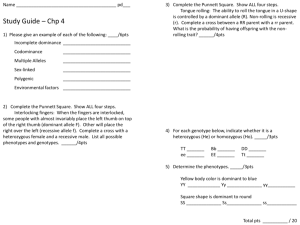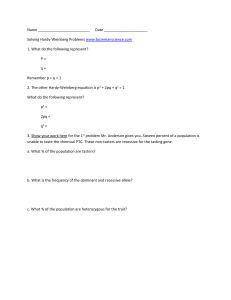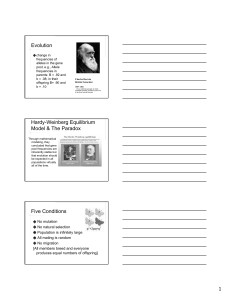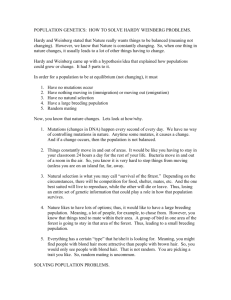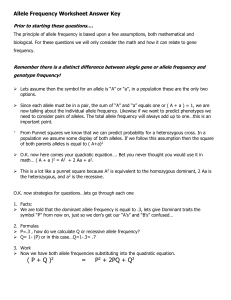HARDY WEINBERG PROBLEMS
advertisement
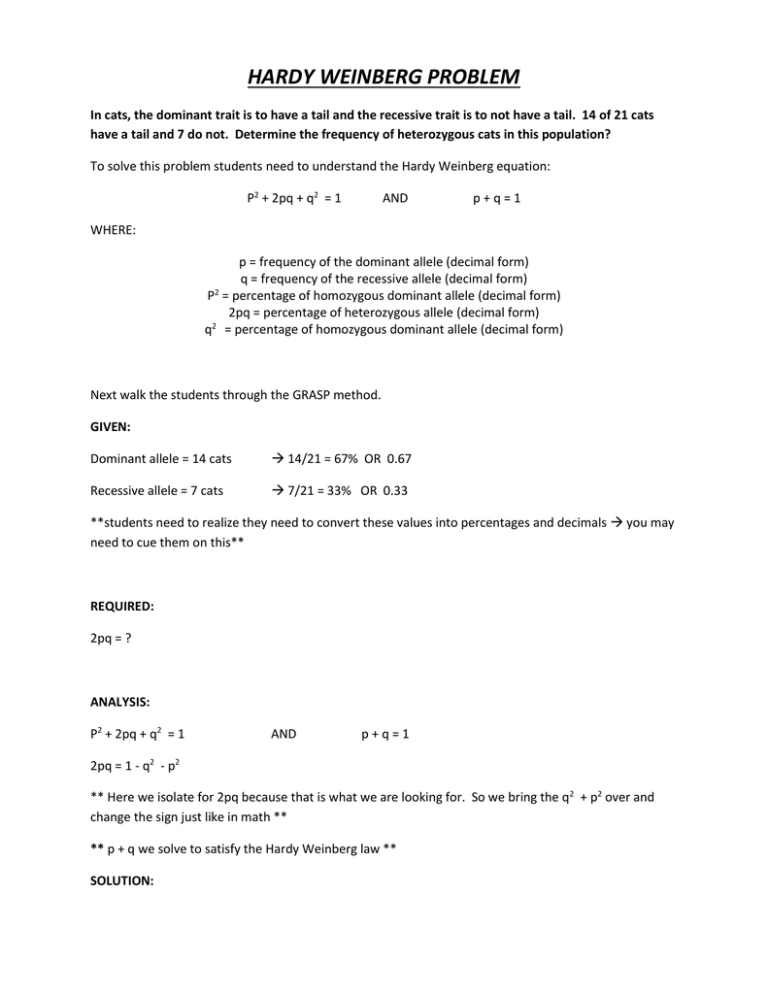
HARDY WEINBERG PROBLEM In cats, the dominant trait is to have a tail and the recessive trait is to not have a tail. 14 of 21 cats have a tail and 7 do not. Determine the frequency of heterozygous cats in this population? To solve this problem students need to understand the Hardy Weinberg equation: P2 + 2pq + q2 = 1 AND p+q=1 WHERE: p = frequency of the dominant allele (decimal form) q = frequency of the recessive allele (decimal form) P2 = percentage of homozygous dominant allele (decimal form) 2pq = percentage of heterozygous allele (decimal form) q2 = percentage of homozygous dominant allele (decimal form) Next walk the students through the GRASP method. GIVEN: Dominant allele = 14 cats 14/21 = 67% OR 0.67 Recessive allele = 7 cats 7/21 = 33% OR 0.33 **students need to realize they need to convert these values into percentages and decimals you may need to cue them on this** REQUIRED: 2pq = ? ANALYSIS: P2 + 2pq + q2 = 1 AND p+q=1 2pq = 1 - q2 - p2 ** Here we isolate for 2pq because that is what we are looking for. So we bring the q2 + p2 over and change the sign just like in math ** ** p + q we solve to satisfy the Hardy Weinberg law ** SOLUTION: 2pq = 1 - q2 - P2 2pq = 1 – (0.67)2 – (0.33)2 ** Plug in the values for p and q and square them using your calculator ** 2pq = 1 – 0.4489 – 0.1089 ** Next subtract the values ** 2pq = 0.4422 pq = 0.4422 / 2 ** Next isolate pq by dividing by 2 ** pq = 0.2211 * 100% ** Multiply by 100% to get the percentage ** pq = 22 % p+q=1 0.67 + 0.33 = 1 PARAPHRASE: Therefore, the frequency of the heterozygous dominant allele is 0.2211 or 22%. GENETICS PROBLEM For Mexican hairless dogs, the hairless condition is dominant to hairy. A litter of eight pups is found; 6 are hairless and two are hairy. What is the genotype of their parents? ** Students need to understand the basic principles of solving basic genetics problems. They need to understand what homozygous dominant, homozygous recessive and heterozygous dominant mean. When solving this problem students need to think about all the possible LOGICAL parent genotypes.** Question to ask students: What are the possible logical phenotypes for the parents and why? GIVEN: H = hairless 6 pups are hairless 2 pups are hairy h = hairy REQUIRED: Genotypes of the pups parents ANALYSIS: HH * Hh HH * HH Hh * hh All possible solutions because they contain both the dominant and recessive alleles which we know is part of the genotypes from the offspring hh * hh Not possible solutions because one dominant or recessive allele is present Hh * Hh SOLUTION: ** Next step includes the students solving all potential solutions ** HH*Hh H h H HH Hh H HH Hh Not a possible solution because the solution is a 1:1 ratio of hairless or hairy. Hh*Hh H h H HH Hh h Hh hh This is the solution because the solution is a 3:1 or 6:2 ratio of hairless to hairy. Hh*hh h h H Hh Hh h hh hh Not a possible solution because the solution is a 1:1 ratio of hairless or hairy. ANALYSIS: Therefore the genotypes of the parents is Hh * Hh to yield a litter of 6 hairless pups and 2 hairy.



